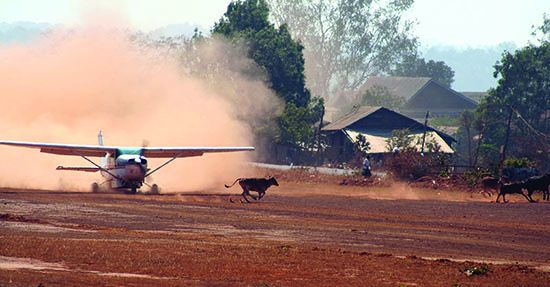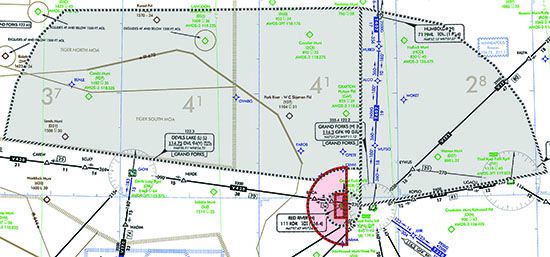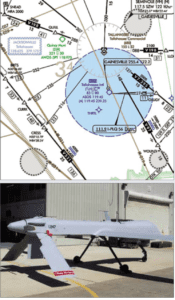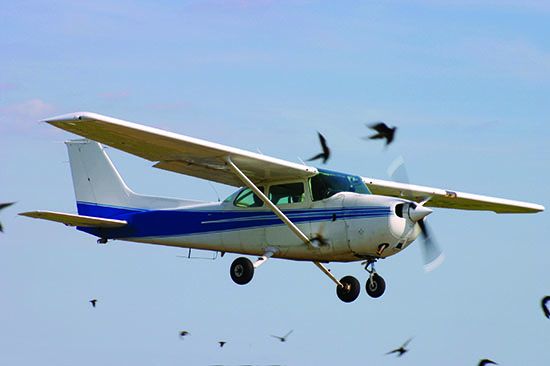As you should know by now, the FAA’s Airport/Facility Directory recently was renamed the Chart Supplement. It’s the same multi-volume reference with information like: “CAUTION—FISH SPOTTING ACTIVITY—CHESAPEAKE BAY AND COASTAL WATERS. Caution is advised for extensive fish spotter aircraft activity between May 1 and December 1 upwards from 1500 feet above the surface over the Chesapeake Bay and adjacent coastal waters. Pilots should be alert for this activity.”
Isn’t that last sentence overkill? Doesn’t the whole “Caution is advised” part mean “Pilots should be alert”? How about this entry for Devils Lake, North Dakota (KDVL)?: “Numerous waterfowl and other birds, deer and jack rabbits on and invof arpt.” The Chart Supplement can spell out “waterfowl” and “jack rabbits,” but can’t spell out “airport” or “in the vicinity of?”
One of my favorites is what the Chart Supplement says about Virginia’s highest-elevation airport, KHSP, Hot Springs: “Wildlife, including bear on and invof airport. Be advised low pass to check/clear wildlife when arprt unattended.” Nothing like buzzing the field to scare off bears—in the mountains.
Maybe the Chart Supplement could save space by just telling us where there isn’t any wildlife to get in the way?
FEATHERED ‘FRIENDS’
Bears at least have the good manners to stay on the ground. In a growing number of places throughout the U.S., bald eagles seem to be thriving. In addition to being a national symbol, their mission is to terrify you with their seven-foot wingspan, never mind the white “death head” and white tail feathers. This symbol of American freedom coming at you at a bunch of knots is enough to make you wish, all of a sudden, that you were flying in another country.
The bald eagle had been endangered, with only 412 known nesting pairs in the CONUS during the 1950s. It’s recovered. That’s the good news. The bad news is that you age eleven years for every eagle near-miss.
At Laughlin Air Force Base in southwest Texas, we had turkey buzzards with eagle-like wingspans. These monster birds would come right to you, at more than 300 knots—most of which were generated by the T-38. At the last possible second, the huge ugly dead-carcass-eating aviator would fold its 25-foot wingspan and tuck and dive—at the exact same moment I’d quickly duck my head so as to get hit in the top of my helmet if the bird came through the windscreen for an interior cockpit tour.
Not that long ago, I was walking back to the FBO at KJYO, Leesburg (Va.) Executive Airport with my student pilot after a late-night flight. There were two guys with an aircraft parked near the terminal building. They said they were flying along just before midnight at 5500 feet and BAM! Birdstrike, right in the windscreen. Sure enough; the blood and feathers left little doubt. I asked them what it sounded like, and one guy said, “It was loud!” They said they figured it was a hawk.

According to the FAA, the first reported bird strike was in 1905. Orville Wright hit one over an Ohio cornfield. The bird’s fate is uncertain. Since then, bird strikes have become a common hazard to aircraft operations. (On the other hand, aircraft operations have become a hazard to birds.) In 2019 alone, the FAA recorded some 17,228 strikes at 753 U.S. airports.
Of course, aircraft can come into conflict with other wildlife. Some things to consider, courtesy the FAA:
• About 53 percent of bird strikes occur from July to October, when young birds leave their nests and fall migration occurs.
• About 63 percent of bird strikes with civil aircraft occur in day, eight during dawn or dusk, with 29 percent occurring at night.
• About 61 percent of bird strikes of civil aircraft occur between initial descent and the landing roll. Thirty-six percent occur during takeoff roll and climb to altitude, with the remaining three percent while en route.
• Mourning doves are the most common species of bird struck by civil aircraft in the U.S., at least among the remains identified from 1990 through 2019.
• Waterfowl (ducks and geese) account for only five percent of strikes but are responsible for 28 percent of the strikes causing aircraft damage.
• Ninety-seven percent of all wildlife strikes with civil aircraft in the U.S. involve birds. Other animals can pose a conflict, also, including deer, coyotes, skunks, bats, alligators and even iguanas have also been reported. White-tailed deer and coyotes are the most commonly struck non-bird species, over the 30-year period from 1990 through 2019.
ROLL THE TAPE
How about deer? Do they run across runways? Why yes, they do. Do they run across holding a rabbit in their mouth and get hit by aircraft? No, but a coyote did just that at my old base, Beale Air Force Base, California, one fine day.
After a fatal crash of a KC-135, where the pilots dorked up the landing, the Air Force implemented a program, where all future landings of all KC-135s would be videotaped from beside the runway, using a video camera mounted on a little freshly poured U.S. Air Force-specification concrete pad. It didn’t take long before one taping crew came into the squadron building chattering excitedly, and punched the tape into the VCR machine. They had been out by the runway, filming tanker landings, and a coyote ran across the runway with a rabbit in its mouth at just the right time: the landing KC-135Q’s nosegear hit it broadside. We watched the tape a lot.
I was landing on Runway 16 at Creve Coeur (“broken heart”) Airport (1H0) in Missouri when I spotted a buck. The deer was well clear to the right of the runway—until he wasn’t. He bolted across the runway in front of me at the last second, when I was on short-short final, a fine rack of antlers on his head. I went around, thinking that even if I can miss this buck and land, there may be another suicidal deer that I don’t see until it’s too late. By the time I came back around, the herd, if there was one, had dispersed.
But then there was the pilot who had two deer strikes in three weeks at Marion County Regional Airport, Flippin, Arkansas, (KMAO). There is absolutely no truth to the vicious rumor that he told reporters, “Three more and I’m an ace!”

It doesn’t matter if what you collide with is wildlife or a man-made object, it can still ruin your day. That most definitely includes uncrewed aircraft and, if you haven’t noticed lately, they are increasing their presence in the National Airspace System.

As Matt points out in this article’s main text, larger UAS like the MQ-9 Reaper pictured at bottom and operated by the 119th Wing of the North Dakota Air National Guard are mixing with civilian traffic at Fargo’s Hector International Airport. The top image here shows TFRs around Grand Forks, N.D., in late February, in red. Some of this activity may be associated with the downing of a suspected spy balloon in early February 2023 near the Canadian border. In any case, the airspace addressed in associated Notams, shown here in gray, only applies between the surface and 100 feet agl. We tend to think if you’re operating an airplane at 100 feet agl, you have a whole different set of problems than an errant UAS, but helicopter operators and aerial applicators may have a different opinion.
Notams about UAS operations aren’t strictly associated with international borders and spy balloons, as evidenced by related Notams near Tallahassee, Fla., and reproduced here also. — J.B.
NOT JUST WILDLIFE
Of course, the Chart Supplement isn’t only about birds and wildlife posing a collision risk. Check out this entry for KFAR, Hector International Airport in Fargo, N.D.: “CAUTION: Use extreme caution for UAS ops in vicinity.” Technically, the North Dakota Air National Guard UASs aren’t “wildlife,” but they look like giant cockroaches, and hearing their radio calls is scary because there’s no windows or pilots on board: “Starship Trooper Bug 25, left base, gear down.” The sidebar on page 22 has much more detail.
How about the Gackle Municipal Airport, 9G9, conveniently located one nautical mile southwest of Gackle, N.D., population 282. This Chart Supplement entry isn’t that odd, since many listed airports throughout the U.S. “feature” a similar runway configuration, where the other end can’t easily be viewed from one end. But it gets slightly better at Gackle.
The Chart Supplement entry for 9G9 reads, in part, “Pilots at end of rwy cannot see acft at opposite end of rwy due to rwy gradient. Rwy 17–35 and Rwy 08–26 turf surface rolling; grass clumpy and possible animal holes. Be alert.”
I see. Runway 08 is 2000 feet long, and the first 200 feet is a five-degree upslope gradient, so you can’t see the other end. So a pilot couldn’t see, say, Bambi charging across the runway until YIKES! And mind the holes. Ya don’t say. Also, the airport’s Chart Supplement entry helpfully adds, “Arpt CLOSED winter due to lack of snow removal.”
Welcome to North Dakota.
NOT APRIL FOOLS
One type of airport hazard you’re not likely to be warned about in the Chart Supplement is a fish strike. A what? On March 30, 1987, an Alaska Airlines Boeing 727 took off from Juneau, Alaska, and had a mid-air with a fish. Supposedly dropped by a bald eagle wanting to lighten its load for better maneuverability in the face of the approaching Boeing, the fish smacked into a cockpit window on being jettisoned. “They found a greasy spot with some scales, but no damage,” Paul Bowers, Juneau airport manager, was quoted as saying in the April 1, 1987, issue of the Juneau Herald.
The point here is that we ignore the Chart Supplement’s information at our peril. Tidbits like these and so many others are there, just waiting for us to find them. To do so, of course, we have to look up the airport we want to use and read the fine print. Diving down into that kind of detail might require a few more taps on your EFB’s screen, but it’s well worth it.
And please let us know if you come across a Chart Supplement entry advising caution for falling fish.
Matt Johnson is former U.S. Air Force T-38 instructor pilot and KC-135Q copilot. He’s now a Minnesota-based flight instructor.




